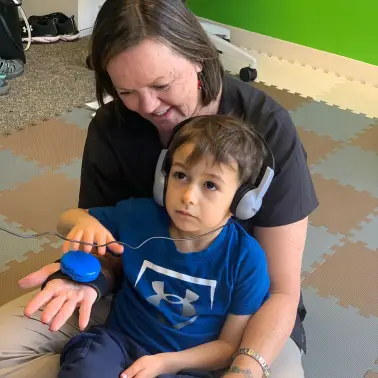No. A diagnosis is helpful during the assessment process, but it’s just a guide and is, many times, wrong especially when it comes to ADD/ADHD. Our assessment covers ten areas:
Dominance: A dominant side should be selected by three years of age. Not selecting a dominant side in terms of their hands, feet, ears, and eyes indicates a problem.
General eye movements: In terms of the brain, the eyes tell a story. We check both slow and fast eye movements as well as convergence of the eyes, peripheral vision, and eye fixation. When the eyes are not tracking properly, you’ll see problems with balance, reading, sports, coordination, focus, driving, rhythm and timing. Information needs to go in properly to be processed properly.
Primitive Reflexes: All brain growth starts from the bottom up. Retained primitive reflexes, stored in the brainstem, inhibit the ability of the left and right hemispheres to properly grow. All primitive reflexes are expected to be integrated by two years of age, with some integrating as early as three months of age.
Rhythm & Timing: Rhythm and timing impacts us in all areas of life such as cognition, attention, focus, memory, speech and language, executive functioning, comprehension, as well as motor & sensory skills. We measure Rhythm and timing based on the number of correctly timed responses to stimulus.
Cognition: We use a variety of scientifically validated brain health assessments for Visuospatial Working Memory, Spatial Short-Term Memory, Working Memory, Mental Rotation, Visuospatial Processing, Deductive Reasoning, Planning, Verbal Reasoning, Verbal Short Term Memory, Attention, and Response Inhibition. We don’t give every child every test. We pick and choose which tasks to administer based on the information provided.
Proprioception: Poor proprioception means the student (what we call a “patient”) will have difficulty interpreting body positions and movements from the muscles and joints. With poor body awareness comes poor social skills. Poor proprioception can cause several signs and symptoms.
Fine motor skills: Poor fine motor skills result in the inability to perform precise movements with the hands and fingers. This can manifest as difficulty with tasks such as writing, drawing, buttoning clothes, or using scissors. Fine motor skills can affect cognitive skills and might impact speech and food choices.
Auditory Processing: An auditory processing deficit will cause delays in language, and further, reading. This shouldn’t be surprising as it is common knowledge that reading is nothing more than language that has been written down. And it is also well known one must be able to hear and process information to learn a language.
Abdominal Core Muscles: Poor musculature results in poor processing in the brain. Abdominal core muscles are the driving force for the brain growth and speed of processing. We test abdominal core musculature using the Presidential Standards.
Coordination: Coordination is the ability to execute smooth, accurate, controlled motor responses. It involves selecting the right muscle at the right time with proper intensity to achieve proper action. Poor coordination can result in injuries and an inability to perform well in sports. More complex and organized movements create a more complex and organized brain. We test coordination using a pattern crawl across the midline.
The comprehensive assessment tells us all we need to know to accurately determine the issues a student faces, the root cause of those issues and what we need to do to correct the root cause.





